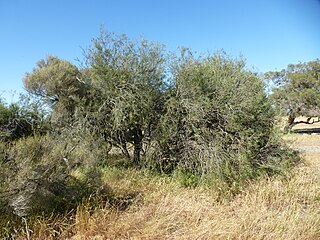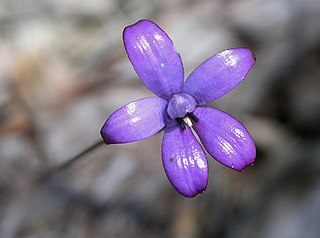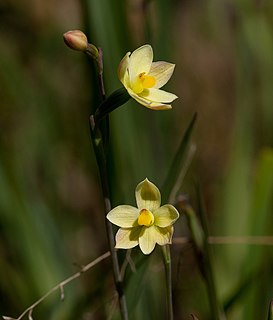
Chorilaena quercifolia, commonly known as karri oak or chorilaena, is a species of bushy shrub that is endemic to the karri forests of south-west Western Australia. It is the sole species in the genus Chorilaena. It has papery, broadly egg-shaped leaves with lobed edges and variously-coloured flowers arranged in umbels of five, the sepals and petals hairy on the outside and the stamens protruding beyond the petals.

Aphanopetalum is a genus of twining shrubs or vines in the family Aphanopetalaceae which are endemic to Australia.

Eremophila deserti is a shrub which is endemic to Australia. Common names for this species include turkey bush, dogwood, poison bushEllangowan poison bush, pencil bush and carrot bush. It is common and widespread in all mainland states, although not the Northern Territory. Some forms are poisonous to stock.

Anthotroche is a genus of shrubs in the family Solanaceae. The genus is endemic to Western Australia.

Phaius tankervilleae, commonly known as the greater swamp-orchid, swamp lily, swamp orchid, nun's-hood orchid, nun's orchid, veiled orchid, Lady Tankerville's swamp orchid or 鹤顶兰 , is a species of orchid native to areas from Asia to islands in the Pacific Ocean. It has large, pleated leaves and tall flowering stems bearing up to twenty five white, brown, mauve and yellow flowers. It was named for Lady Tankerville who owned the greenhouse where the first orchid flowered. It was the first tropical orchid to flower in England.

Tribonanthes a genus of Australian plants endemic to Western Australia in the bloodwort family, Haemodoraceae.

Eremaea pauciflora is a plant in the myrtle family, Myrtaceae and is endemic to the south-west of Western Australia. It is a shrub with small leaves and orange flowers at the ends of its branches. It has the most widespread distribution of the eremaeas with considerable variation in its characteristics so that three varieties are recognised. It was the first Eremaea to be described formally but was not originally given the name Eremaea.

Thomasia macrocarpa, commonly known as large-fruited thomasia, is a shrub that is endemic to the southwest of Western Australia.
Dendrobium brachypus, commonly known as the dwarf cane orchid, is an epiphytic or lithophytic orchid in the family Orchidaceae. It has crowded, yellowish green pseudobulbs, dark green leaves and two or three cream-coloured to whitish or greenish flowers which often do not open fully. It grows on trees and rocks on one mountain on Norfolk Island.

Melaleuca teretifolia is a plant in the myrtle family, Myrtaceae, which is endemic to the south-west of Western Australia. It is a shrub with long, thin leaves and clusters of usually white flowers along considerable lengths of the branches in late spring and summer.

Verticordia fimbrilepis, commonly known as shy featherflower, is a flowering plant in the myrtle family, Myrtaceae and is endemic to the south-west of Western Australia. It is a small, bushy shrub with one openly branched main stem at its base, small, pointed leaves and rounded groups of pink flowers near the ends of the branches.

Caladenia brunonis, commonly known as the purple enamel orchid, is a plant in the orchid family Orchidaceae and is endemic to the south-west of Western Australia. It is a ground orchid with a single flattened, hairy leaf and up to three glossy purple flowers. It has recently been known as Elythranthera brunonis since 1963 but recent discoveries suggest its inclusion in the genus Caladenia.

Thryptomene australis, commonly known as hook-leaf thryptomene, is a species of flowering plant in the family Myrtaceae and is endemic to the south-west of Western Australia. It is an erect, bushy and spreading shrub with upward-pointing leaves with the tip curving outwards, and flowers with white petals arranged spike-like near the ends of the branchlets.

Tribonanthes violacea belongs to the genus Tribonanthes in the bloodwort family, Haemodoraceae. It was first described by Stephan Endlicher in 1846. It is a perennial herb growing from 0.05 to 0.2 m high, in peat, white, grey or yellow sands, clay loams and granite in areas which are seasonally wet and on granite outcrops. Its white to purple flowers are seen from July to October.

Tribonanthes purpurea belongs to the genus Tribonanthes in the bloodwort family, Haemodoraceae. It was first described by Macfarlane and Hopper in 1987. It is a perennial herb growing from 0.03 to 0.04 m high, in seasonally wet moss and herbfields among granite rocks. Its pink to purple flowers are seen in August.

Daviesia divaricata, common-name Marno, is a shrub in the family Fabaceae. It is endemic to Western Australia. It usually grows from 0.3–3 metres (1–10 ft) high. Bentham describes it as having no leaves, and having smooth, green, rigid stems which are circular in cross-section (terete), having grooved spines at their tips. Stems branch off from one another at a wide-angle, giving the species its name, divaricatus being the Latin for wide-spreading. Its orange pea flowers, with their yellow, brown, red and purple centres, are produced between June and November in the species' native range. It grows on sand, over both limestone and laterite, and is found on sandplains, rocky outcrops, and roadsides.

Thelymitra flexuosa, known as the twisted sun orchid, is a species of orchid that is endemic to southern Australia. It has a single thin, wiry leaf and up to four cream-coloured to canary yellow flowers with four rows of short hairs on the back of the column. It is a common and widespread species, superficially similar to T. antennifera.

Scaevola canescens is a species of plant in the family Goodeniaceae. It is endemic to Western Australia where it occurs "from Shark Bay to Perth, in open forest and heath in sandy soil".

Macarthuria australis is an erect or spreading, wiry shrub, in the family Macarthuriaceae endemic to Western Australia. It grows from 0.15-0.75 m high and has white/white-cream flowers, and may be seen in flower from May to February although mainly from August to September. It grows on sand and laterite, on coastal sandplains, sandhills, and roadsides.
Philotheca brevifolia is a species of flowering plant in the family Rutaceae and is endemic to a small area in south-western New South Wales. It is a spreading shrub with fleshy, sessile, cylindrical leaves and white to pink flowers arranged singly or in small groups on the ends of branchlets.



















